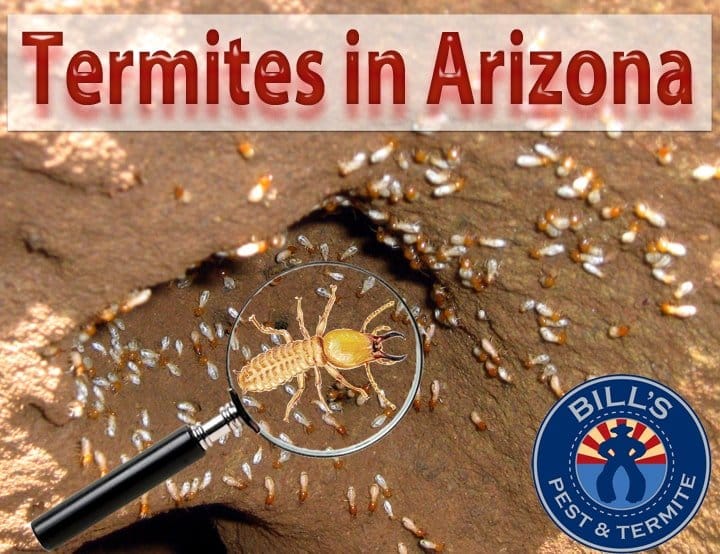
Termites in Arizona
Termites in Arizona | Types of Termites
Looking for info on Termites in Arizona? We can help! Welcome to the internet home of Bills Pest Termite Control your hometown exterminator. Family-owned and locally operated we are Arizona’s Termite Experts.
If you have a problem with termites give us a call. Bills Pest Termite Control is family-owned and locally operated. We provide free inspections, evaluations, second opinions, and reports for real estate transactions. If you have or suspect a problem with termites Bills Pest Termite Control should be your first call. We have the experience to eradicate your termite problems.
Termites in Arizona
“Depending upon which expert you talk with Arizona has 17-25 different Termite species.”
Termites are considered Arizona’s #1 urban pest threat. As an Arizona homeowner, it’s just a matter of time before you encounter termites. If, and when this problem shows up at your doorstep it’s important to not panic. Knowledge is power. Unlike the termite cartoons, many of us saw as youngsters Arizona termites can take months, years, or even decades before structural damage occurs.
Arizona is home to at least 18 different species of termites. Not all termites are the same. Not all types of termites will be a threat to your home. Only a few of the 18 species of Arizona termites are economically important.
Types of Termites in Arizona
Termites can be placed into 3 general categories, subterranean, drywood, and dampwood termites. Even within these categories habits, threat levels, and treatment methods will vary.
Generally, Arizona dampwood termites are not a threat to structures. Like anything in life, there are exceptions. With the right conditions, this species can be destructive. Getting rid of this pest may not require the use of expensive products and/or strong chemicals. Correcting conditions conducive to infestation can remediate this problem.
Western Drywood termites can be the most destructive species in Arizona. Fortunately, they are not as common as subterranean types of termites. Treatment methods for this species can vary from simply removing infested wood to liquid spot treatments, heat treatments, and the more expensive whole structure fumigation. A proper inspection by a trained and experienced termite inspector is important to select the most effective treatment service.
Subterranean-type termites are the dominant species in Metropolitan Phoenix and Tucson. They are considered a major urban pest threat. Subterranean termite treatment methods vary by species. Depending upon the species an infestation can be corrected by removing infested wood, spot treating areas of infestation, and/or servicing the entire structure.
FREE TERMITE INSPECTION
If and when you discover or suspect a termite problem remain calm. Breath deep and relax. The next step is to request a FREE TERMITE INSPECTION. Not all termite inspectors are the same. Finding an experienced and well-trained inspector can be a challenge. Most termite inspectors in Arizona have a couple of years or less experience. An inexperienced inspector can miss the subtle signs of infestation or worse yet misdiagnosis the species or type(s) of termites attacking a structure.
Termites in Arizona can be divided into four subgroups (click to read more):
Desert Termites Subterranean Termites Drywood Termites Dampwood Termites
Arizona Desert Termites
Desert termites are the most common subterranean termites in Arizona.
Arizona desert termites are usually found on wood fences and/or around desert plants including cactus, Palm trees. While desert termites won’t normally invade homes they are often found in the crawl spaces of manufactured homes. Left unchecked Desert termites can cause severe structural damage and are known for damaging wood utility poles.
The Desert subterranean is a pale yellowish-brown and a fontanelle (front gland pore) is indistinct or absent. The wings have two prominent hardened veins in the front portion. The wing membrane is translucent, almost colorless, with a few barely visible hairs. The front wing is larger than the hind wing. The head of the Arizona desert termite soldier is rectangular in shape, the length about twice the width. It also has a fontanelle (front gland pore) on the forehead. The body (pronotum) is flat and almost as wide as the head.
The Desert termite soldiers have long powerful pointed jaws (mandibles) that are slender, fairly straight but slightly curved inward at the tip. This contrasts with the mandibles of other Phoenix area termites that are thick and curved.
The small size of Arizona desert termites and their ability to forage under dry conditions allows them to occupy a niche not exploited by other Arizona termite species.
Arizona desert termites prefer to eat the springwood in timbers, generally avoiding the lignin in summerwood. Damaged timber appears honeycombed, with soil in the galleries.
Arizona Termite Control Services
The Arizona desert termite is less dependent on moisture and decay than other Phoenix area termites. It will readily attack dry, sound wood. A typical sign of an infestation is the presence of “drop tubes” coming from the ceiling rafters and sheetrock/plasterboard and/or holes in the sheetrock plugged with feces.
Arizona desert termites prefer to forage in shaded soil or areas made wet by irrigation.
They will readily construct mud shelter tubes up, over, or around solid objects in order to reach a timber food source. These mud tubes are slender, solidly built, and pale yellow to tan in color.
The mud-tubes are more circular in cross-section than those of other Phoenix area subterranean termites whose mud tubes are flattened in cross-section and dirty light brown in color.
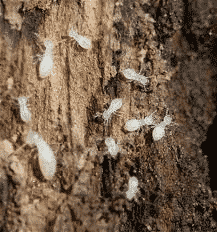
Desert termites require only a tiny gap, about 1/32″, in concrete flooring or mortar joints in brick walls to gain access to the wall, roofing, and other structural timbers in a building. The Arizona desert termite can penetrate cracks in concrete and masonry that are too narrow for foragers of other Phoenix area termite species to enter.
Desert termites in Arizona often build thick free-standing mud-shelter tubes that appear to drop down from rafters, ceilings, and subfloor areas under buildings. It is considered the most common and destructive termite in Arizona.
In Arizona locations below 4,000 feet, the Desert termite can swarm between January and August. Above 4,000 feet, they usually swarm in June and July. The swarmers are about 1/3” long with wings, and 1/5” long without wings. Their wings are almost whitish, with brown veins in the fore area. They are dark brown to black in color. The soldiers are 1/4″ long, with jaws that are nearly straight. They resemble the jaws of the desert termite but are slightly thicker.
Biology and Habits: The Arizona desert termite has been found living in sand dunes, as well as at altitudes above 7,000 feet along the Mogollon Rim.
It is also found in moist river low lands and along streams and canyons, but essentially it is a desert or prairie species. Arizona desert termites naturally occur in deserts where they attack creosote and greasewood bushes as well as buildings and other timber structures.
Arizona Subterranean Termites

Arizona subterranean termites in Arizona are social insects that live in colonies beneath the soil. They contain three forms, or castes: reproductives, workers (pseudergates), and soldiers. Individuals of each caste have several stages: the egg; the larva that develops into a pseudergate and eventually into a brachypterous nymph or soldier; and the adult. There are three forms of adult reproductive termites primary, secondary and tertiary. Reproductive termite males and females can be winged (primary) or wingless (secondary or tertiary). Females of each can lay eggs and produce offspring. The bodies of winged primary reproductive are, also called swarmers or alates, vary by species from coal black to pale yellow-brown. Wings may be pale or smoky gray to brown and have distinct vein patterns used in identification. Arizona Reticulitermes swarmer termites are about 1/4 to 3/8 inch long. Secondary and tertiary reproductive’s live within the colony and are white to cream-colored. These termites form a backup for the primary queen and may replace her if she is injured or dies. Arizona termites mate within the colony and lay viable eggs. If supplementary reproductive’s and worker termites become isolated from the main colony, they can establish a new sub-colony.
Free Termite Inspections
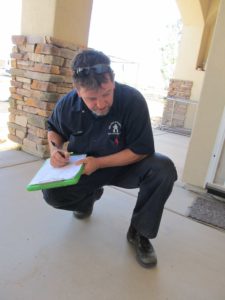
Soldiers resemble workers in color and general appearance, except they have well-developed brownish heads with strong mandibles or jaws. Soldiers defend the colony against invaders, primarily ants, and other termites. They cannot forage for food or feed themselves, and they depend on the workers to care for them.
Termite Swarmers
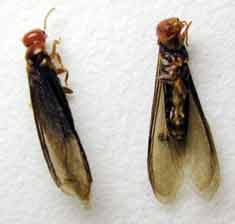
After 2 to 4 years a subterranean termite colony is mature and produces “swarmers” (winged primary reproductives). Arizona termite swarmers typically leave their colony in large numbers during the Arizona monsoon season. Environmental factors such as heat, light, and moisture trigger the emergence of swarmers, with each species having its own set of requirements. The number of swarmers produced is proportional to the age and size of the colony.
Both male and female swarmers fly from the colony and travel short distances. Termites are weak fliers and must rely on wind currents to carry them to new habitats. Only a small percentage of swarmers survive to develop colonies; most fall prey to birds, toads, insects, and other predators, and many die from dehydration or injury. During the swarming process, males (kings) and females (queens) pair off using pheromones. Successful reproductive pairs land, lose their wings and seek cover under rocks or other moist materials. A pair will make a very small nest before mating. Initially, the new queen termites lay only a few eggs. The male remains with the female and helps care for developing eggs and the larva that hatch. Eggs are not deposited continuously. In fact, only a few hundred are deposited during the first year. As the young queen grows larger, she lays more eggs. The king and queen care for the young larvae that hatch from the eggs because they cannot care for themselves. The larvae then molt into pseudergate workers, which in turn can molt into pre-soldiers or brachypterous nymphs (with wing pads). These nymphs will eventually molt to become primary reproductives. The colony stabilizes when the queen reaches her maximum egg production. If the queen dies, supplemental reproductives take over the queen’s duties.
The maximum size of a termite colony depends on location, food availability, and environmental conditions, especially temperature and moisture. Some colonies remain small; others contain up to several thousand individuals. New colonies form when groups of termites become isolated from the main colony and establish sub-colonies. This is called “colony splitting” or “budding.” These sub-colonies may exist independently or reunite with the main colony.
Termite Cellulose
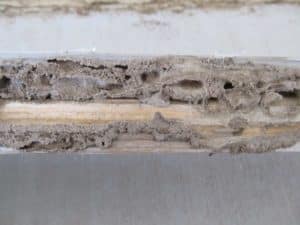
Arizona subterranean termites also must protect themselves from temperature extremes and attacks by ants and other insects. Termites that forage for food above ground protect themselves with shelter tubes or “mud tubes”. Worker termites build shelter tubes from particles of soil or wood and bits of debris held together by salivary and fecal secretions. Mud tubes may be thinly constructed or can be large with thick walls to accommodate many termites moving vertically between the soil and their food source. Subterranean termites also transport moist soil into the structures they infest. The presence of shelter tubes and mud within galleries is used to identify termite-damaged wood. Shelter tubes are often used to bridge across masonry or other objects, allowing termites access to a food source (wood) above ground. Inspecting structures for termite damage may identify these tubes which indicate an ongoing infestation.
Dead trees and brush provide a natural food source for foraging Arizona subterranean termites. When natural vegetation is cleared and houses are built, termites often switch to feeding on wooden structures. Termites enter buildings through wood that is in direct contact with the soil and by building shelter tubes over or through cracks in foundations. Any cellulose material in direct contact with the soil, such as trees, vines or plumbing fixtures, can serve as an avenue of infestation.
Best Prevention = Yearly Inspection
Active termite infestations can be difficult to detect. To find out if a home is infested, the structure should be inspected at least once a year for evidence of swarmers (including wings or dead termites in windows), mud tubes, or damaged wood inside or around a structure.
Swarmers: Generally, the first sign of infestation homeowners notice is swarming reproductives on windowsills or near indoor lights. Swarming termites inside the house usually indicate an active infestation in the structure. Termite wings may be found on window sills or stuck to cobwebs indoors. Though swarmers outdoors are a natural phenomenon, they indicate that termites are present and may be attacking nearby structures.
Termite tunnels or Mud tubes
Mud tubes: Mud shelter tubes on crawl space piers, utility penetrations, or on foundation walls and slabs are a sign of termite infestation. Termite shelter tubes can blend in well with the soil or concrete, making them difficult to see. To make inspecting the home for termites easier, prune vegetation away from the house walls. The soil line should be several inches below the top of slabs or foundation walls. An inspector should look for mud tubes carefully along cracks, in corners, or where the top of the foundation is close to the ground. A screwdriver is useful to break open suspected termite tubes and detect live termites. Wood damage often is not found initially but is a positive indication of a current or past termite infestation. Wherever wood comes in contact with the soil there is a high risk for termite entry. Carefully examine any wood that thuds or sounds dull when struck by a screwdriver or hammer. Probing suspected areas with a sharp instrument such as a screwdriver or an ice pick will often disclose termite galleries or damage.
Arizona subterranean termite damage is usually confined to the soft, spring-growth of wood. Termite tunnels and galleries tend to follow the wood grain and are lined with mud or may have a pale, spotted appearance resulting from soft fecal material plastered on tunnel surfaces. Moisture sources may cause wood decay and can encourage subterranean termite infestation. Deterioration caused by wood-destroying fungi can be confused with termite damage.
Drywood Termites in Arizona
The Western drywood termite accounts for most of the drywood termite damage in Arizona.
Colonies contain up to about 2,000 termites. Severe damage may be caused by the presence of multiple-colonies. It is easily transported outside these areas in infested furniture and other timbers. This termite lives in timber with a moisture content of less than 12%.
Drywood termites in Arizona are often distributed by human activity, commonly by transporting infested furniture, picture frames, and wood to new areas. It has failed to become established in such areas outside its normal southern and mostly coastal range.
Swarmers are about 1/2″ long including wings their wings are 3/8″ long. The head and pronotum of the swarmer are orange-brown and its abdomen is dark brown. The front wing has 3 dark, heavily hardened veins in the front portion.
The forehead of the soldier slopes down gradually from the top of the head, head flattened to slightly rounded inside view, and head orange to reddish-brown with the eyespot whitish. Soldiers have mandibles with an unequal number of teeth on each member of the pair, and an antenna with the third segment greatly enlarged and club-like.
Although colony development is slow, severe structural damage may still be caused by the presence of multiple colonies. Drywood termites eat across the wood grain and create chambers or galleries connected by tunnels.
Their gallery and tunnel walls are velvety smooth, and no soil is present. Generally, there are fecal pellets present. They are hard, less than 1/32″ long, elongate-oval with rounded ends. One of the unusual distinctive signs of their fecal pellets is that they have 6 concave sides.
Evidence of infestation includes swarmers, shed wings, piles of pellets, termite plugs that seal all openings in infested wood, and surface blisters caused by older, enlarged galleries very close to the wood surface.
Free Drywood Termite Inspection 602.308.4510
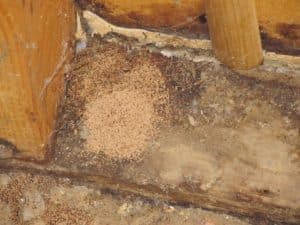
After the mating flight, they seek cracks or knotholes in a nearby wood and chew a small tunnel which they close then excavating a chamber after which they mate. After 3 years to 4 years, the colony may consist of up to 1,000 members.
The first swarmers may be released when the colony is approximately 4 years old. Swarming typically takes place about midday on sunny, warm (80°F) days, with the peak of the swarm occurring shortly after a sudden rise in temperature. It typically occurs during September and October. Swarmers usually number in the dozens, occasionally the hundreds. Night swarmers are attracted to lights. Swarming drywood termites fly into structures and infest wood directly. When swarming, they often reinfest the same structure. They typically first infest exposed wood such as window/door frames, trim, eaves, and attics. They do so by finding a protected crevice or other areas, such as the joint between 2 pieces of wood, where shingles/paper overhang timber or molding, etc., and then attack the wood.
Dampwood Termites in Arizona
The Arizona dampwood termite is the largest and most significant dampwood termites in Arizona. Though not commonly found in dry states like Arizona active infestations of Pacific dampwood termites have been found in areas of Metro Phoenix like the Encanto Park area and the western edges of Mesa. They are more commonly found in the cool and humid coastal areas of California and the east coast.
Termite Swarming may occur throughout the year, but most often from May through August. Termite swarming usually will occur on warm humid evenings just before sunset. The reproductives are strongly attracted to light. Swarmers are up to 1″ in length and are light to medium brown with dark brown wings.
Soldiers have a large head armed with long black-toothed mandibles. The anterior portion is black generally shading to a dark reddish-brown in the posterior position. The abdomen and thorax are a light caramel color, the abdomen varying according to the stomach contents at the time. The largest termites in the United States, soldiers may be very large, reaching 5/8 to 3/4″.
Termite tunnels vary greatly in size and shape and in sound timber may favor the softer springwood. Fecal pellets are found throughout the tunnels and are hard small, oval, and about 1/25 “ long. The color of the pellets may vary according to the type of wood being consumed.
Arizona dampwood termites will attack wood of all types throughout Arizona. Timbers in contact with the soil or structures built near or over water are common targets. This species is known to be very tolerant of moist conditions, even being found in pilings subject to tidal flooding. Colony size varies but may contain as many as 4,000 individuals.
Talk to an Arizona Termite Expert
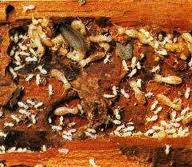
The life history of the Arizona dampwood can be summarized as follows. Both male and female swarmers excavate a chamber, they enter, and the chamber is sealed. They mate and within about 2 weeks, eggs are laid and the colony is founded. The queen lays about 12 eggs. The second batch is laid the next spring.
Termite swarmers of this species are dark brown, swarming during the daytime.
Dampwood termites in Arizona infest wood at or below the ground level usually in damp crawl spaces. It sometimes girdles young citrus trees and grapevines below the soil line in desert areas. In the Phoenix area, dampwood termites attack living trees and bushes, and is a problem for citrus groves. It is a pest of timbers in service, infesting moist timbers that are in contact with the soil including utility poles. Untreated posts, poles, and fences are attacked below ground level.
Arizona dampwood termites do not build mud shelter tubes above the ground in order to reach the wood. The colonies extend from the wood into the soil, they sometimes kill living shrubs and trees, frass is cone-shaped rather than cylindrical, and the termites have a pungent odor. They also have directed trail-following behavior, unlike other dampwood termites.
Given the heavy termite pressure in Metro Phoenix, it is recommended that every home be inspected at least once a year for Termites in Arizona by a trained professional who has the experience to detect the many different types of termites that call the Phoenix Arizona area home. For more information about termites in Arizona or how do I tell if I have termites give us a call.
Termites in Arizona 602.308.4510
Related Termite Content:
- What months are termites most active?
- Best Termite Control Methods and Treatment Options
- Desert Termites
- Best Termite Control Company in Phoenix, AZ
- Are Termites an Issue in Arizona?
- How much is a Termite Inspection?
- Termite Extermination
- What is the average cost for Termite Treatment?
- Termite Treatment Phoenix AZ
- Soil Termite Treatment versus Termite Baiting
- Drywood Termites
- How do I know if I have Termites?
- Best Termite Companies
- Termite Treatment Scams
- Termite Damage
- No Drill Termite Treatment
- Termite Foaming
- Mesa Termite Services
- Cricket or Termite Droppings
- Wikipedia Termites
- Termite Facts
- How to get rid of Termites
- Termite Baiting
- Arizona Termites
- Heterotermes
- Termite Dropping from Ceiling
- Can termites make you sick?
- Termite Tubes in the Ceiling
- Mud Looking Strings Hanging
- Borate Termite Treatment
- Home Inspectors and Termite Reports
- Arizona Termite Specialists
- Termite Droppings
- Why is Termite Control Expensive
- What are Termites
- Termite Treatment
- Control de Termitas
- Are Termites Harmful to Humans?
- Green Termite Control
- Why you need Termite Control


